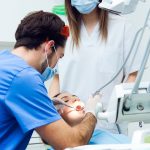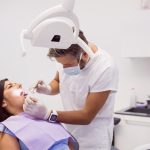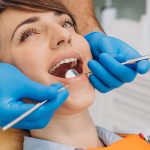
MAJOR ORAL SURGICAL PROCEDURE-
1.Jaw Cysts and Tumors-
Cysts and tumors can form in and around your jaw. Most growths are benign (noncancerous).
Rarely, they’re a form of jaw cancer. These abnormal growths behave differently depending on
type. Some grow slowly while others grow fast, get big and damage nearby tissue or displace
teeth. The most common treatment is surgery.
What are jaw cysts and tumors?
Jaw cysts and tumors are growths that can form from bone (including teeth) and soft tissue in
your mouth. A jaw cyst is a sac of fluid or semi-liquid material. A jaw tumor is a solid mass that
forms when abnormal cells clump together. Both growths are usually benign (noncancerous).
This means that, although they may grow and impact tissue in your face and mouth, they usually
don’t spread to other parts of your body.
In rare instances, jaw cysts or tumors are malignant (cancerous). Healthcare providers refer to
them as jaw cancer. Without treatment, malignant jaw cysts and tumors can spread to body parts
other than your jaw.
It’s essential to get any new growth in your jaw or mouth checked. Even if a tumor or cyst is
benign, some types can still hurt and damage your jaw or displace teeth.
Types of jaw cysts and tumors
There are several types of jaw cysts and tumors. Providers classify them based on whether
they’re benign or malignant. They also consider whether they start in tissue involved in tooth
development (odontogenic cysts and tumors) or from other tissue (nonodontogenic cysts and
tumors).
The most common types of benign jaw cysts and tumors include:
- Ameloblastoma: A slow-growing odontogenic tumor that usually forms in your lower
jaw near your back teeth (molars). It’s usually benign, but some forms of ameloblastoma
may become malignant over time. Even benign tumors can grow big enough to change
the structure of your jaw or damage your teeth. Central giant cell granuloma: The most common benign non-odontogenic tumor. It
usually forms in the front part of your lower jaw, but it can also develop in your upper
jaw. Most tumors only cause painless swelling in your jaw. But fast-growing tumors can
cause painful swelling and displace teeth.Dentigerous cysts: The second most common odontogenic cyst. They’re slow-growing
cysts that form around the tissue of teeth that haven’t pushed into your mouth (erupted)
yet. They usually form near your back teeth (molars). Sometimes, they appear near the
teeth on either side of your upper front teeth (upper canines).Odontogenic keratocysts: Slow-growing cysts that usually form near your molars.
Smaller keratocysts aren’t usually painful, but large cysts can cause painful swelling.
These cysts may be a sign of an inherited condition called Gorlin syndrome. This
condition increases your risk of odontogenic keratocysts and some forms of skin cancer.Odontogenic myxoma (myxofibroma): A benign, slow-growing tumor. But these
tumors can grow big enough to damage your jaw and displace your teeth.Odontoma: The most common benign odontogenic tumor. One type usually forms in
your lower jaw and contains multiple tooth-like structures (compound type). The other
type usually forms in your upper jaw and contains unusual masses that don’t resemble
teeth (complex type).Periapical cysts: The most common type of jaw cyst. They form when there’s an injury
to a tooth that causes inflammation.
Malignant jaw cysts and tumors include rare forms of:
- Carcinoma: Cancer that starts in the tissue lining your organs, internal passageways
and skin. - Sarcoma: Cancer that starts in bone or surrounding soft tissue.
- Carcinosarcoma: Cancer that’s a mix of both carcinoma and sarcoma.
How common are jaw cysts and tumors?
Jaw cysts and tumors are uncommon, and malignant types are especially rare.
Research shows that people in some regions may be more likely to develop them than in other
areas. For example, odontogenic tumors account for just 1% of atypical oral (mouth) growths in
North America but nearly 20% in some African countries.
Symptoms and Causes
What are the symptoms of a cyst or tumor in my jaw?
Most cysts and tumors are slow-growing and don’t cause symptoms. You may not know you
have one until they show up incidentally on a dental X-ray or another imaging test related to a
head and neck issue.
But large growths that start to take the place of nearby healthy tissue can cause symptoms,
including:
- Jaw pain, tenderness or numbness.
- Swelling (may or may not be painless).
- Changes in the way your face looks.
- A new lump on your jawbone (may be hard or soft).
- Changing bite.
- Loose teeth.
What causes jaw cysts and tumors?
Most jaw cysts and tumors form when the cells that eventually form teeth behave abnormally
and form masses (tumors) or fluid-filled sacs instead. This is what happens with odontogenic
growths. But the cells don’t have to be involved in tooth formation to grow abnormally.
Odd cell growth often happens because of DNA changes (genetic mutations). DNA contains the
instructions, or code, that tell cells how to grow, including when to stop. Problems with the code
can disrupt cell division processes and cause overgrowths.
For example, people with Gorlin syndrome (nevoid basal cell carcinoma syndrome) have
mutations that cause cells to continue multiplying and dividing when they shouldn’t. As a result,
people with the condition often get multiple odontogenic keratocysts and are at increased risk
of basal cell carcinoma, the most common skin cancer.
Diagnosis and Tests
How are jaw cysts and tumors diagnosed?
Your healthcare provider will review your symptoms and medical history and perform a physical
exam. Imaging tests can show tumors or cysts in and around your jaw. They include:
- X-rays.
- Magnetic resonance imaging (MRI).
- Computed tomography (CT) scan.
You’ll also need a biopsy. During a biopsy, a provider removes a sample of fluid or tissue from
the growth. A pathologist examines the sample under a microscope to determine the type of cells
it contains. This information tells your provider:
- What type of cyst or tumor you have.
- Whether it’s benign or malignant.
- Whether it’s slow-growing or aggressive.
All these factors help your provider determine the best treatment options.
How are jaw cysts and tumors treated?
Most people need surgery to remove the cyst or tumor. In addition to removing the growth, your
surgeon may also remove any affected tissue. This includes damaged teeth or parts of your lower
or upper jaw. Surgery to remove segments of the lower part of your jaw is called
a mandibulectomy. Surgery that removes all or part of your upper jaw is called maxillectomy.
Following surgery, you may need treatments to rebuild your jaw and help with recovery,
including:
- Reconstructive surgery: Your provider may remove a segment of bone from another
part of your body (like your hip, shoulder blade or lower leg) to make your jaw look like
it did before you had a growth. - Dental implants: You may need artificial teeth to replace the ones that your provider
pulled. - Speech therapy: A speech-language pathologist (SLP) can help improve your speaking
if you’re having trouble talking and being understood after surgery. - Nutrition guidance: You may need to meet with a nutrition specialist, like a dietitian or
nutritionist, who can advise you on what foods you can safely eat as you heal.
What can I expect if I have a jaw cyst or tumor?
Surgery can cure most jaw cysts and tumors. Depending on the type, you may need follow-up
visits to monitor new growths.
For example, periapical cysts, odontomas and dentigerous cysts don’t usually grow back (recur)
after surgery. But central giant cell granuloma, odontogenic myxoma and odontogenic
keratocysts often do. Ameloblastoma recurs in up to 20% of people.
When should I seek care?
See your healthcare provider if you’re experiencing pain or swelling in your jaw or if you notice
a change in your appearance, like a lump on your jaw or shifting teeth. It may be a sign of a cyst,
tumor or a separate dental condition your provider can treat.
It’s especially important to visit your dentist regularly. A routine dental X-ray can show signs of
a cyst or tumor when it’s still small and isn’t causing symptoms.
What questions should I ask my ORAL SURGEON?
Questions to ask include:
- What type of tumor or cyst do I have?
- Is it benign or malignant?
- Will I need surgery?
- How likely is it that it will return after surgery?
- How can I care for myself while I’m recovering from surgery?
When should I be worried about a lump on my jawline?
Many conditions can cause a lump on your jawline, and most aren’t serious enough to worry
about. Causes include cysts and tumors — but the issue may be as simple as an allergic reaction
or a swollen lymph node.
It may be helpful to keep in mind that most benign growths feel soft and moveable when you
touch them. If a growth is cancerous, it’s more likely to feel hard. The exception is liposarcoma,
which is a cancer that may feel like a soft and moveable mass.
If you have a new lump that doesn’t go away, is painful and interferes with your ability to move
your jaw — it’s time to see a provider.
2.Facial Fractures
Facial fractures are broken bones in your face, which can include your jaw, nose and eye sockets.
Common causes include motor vehicle accidents, falls, physical assault and gunshot wounds.
Treatment typically involves surgical reconstruction.
What are facial fractures?
Facial fractures refer to broken bones in your face. This type of facial trauma (also called
maxillofacial trauma) can happen if you’re involved in an accident, such as a car crash or fall.
Facial fractures are also common among victims of physical assault and gunshot wounds. Your
facial bones are thinner than a lot of other bones in your body, making them prone to injury.
Types of facial fractures
The most common facial fractures include:
- Nasal fractures (broken nose).
- Forehead fractures (broken frontal bone).
- Orbital fractures (eye sockets).
- Zygomatic fractures (cheekbones).
- Tripod facial fracture (involving your eye socket, cheekbone and upper jaw).
- Maxillary or mandibular fracture (broken jaw).
- Mid-face fractures (Le Fort fractures).
What are the symptoms of a facial fracture?
General symptoms may include:
- Bruising.
- Swelling.
- Pain or tenderness.
- Facial numbness.
- Disfigurement.
If you have a broken nose, you may have:
- Difficulty breathing through your nose.
- Nosebleeds.
If you have fractured eye sockets, you may develop:
- Blurred vision.
- Double vision.
- Bulging eyeballs.
- Sunken eyeballs.
- Difficulty moving your eyes up, down or back and forth.
Fractured jaw symptoms may include:
- Drooling.
- Difficulty chewing or speaking.
- Pain when opening your mouth.
- Loose, broken or missing teeth..
What causes facial bone fractures?
The most common cause of facial fractures is physical assault, followed by vehicular accidents
and falls. Other causes include:
- Sports-related injuries.
- Workplace accidents.
- Domestic violence.
Diagnosis and Tests
How are facial fractures diagnosed?
During a visit with a healthcare provider, they’ll:
- Determine if you have any life-threatening injuries. (If you do, they’ll address them right
away.) - Check your nasal passages and airways for obstruction.
- Look at your eyes to see if they’re functioning properly.
- Check for damage to your central nervous system (your brain and spinal cord).
- Ask you to describe your symptoms.
- Ask about your facial injury and how it occurred.
- Check your face for asymmetry or damage.
- Gently palpate (press on) the bones of your face to determine the extent of damage.
What tests help diagnose facial fractures?
Imaging tests help healthcare providers diagnose facial fractures and rule out other issues like
dislocation. Computed tomography (CT) is the most common imaging test used for diagnosing
facial fractures.
How are facial fractures treated?
Your healthcare provider may prescribe pain relievers as well as corticosteroids to ease swelling.
They may also prescribe antibiotics if there’s a high risk of infection.
Facial fracture treatment involves reduction and fixation.
- Reduction: resetting the broken bones and placing them in their correct positions.
- Fixation: keeping the bones in their new positions long enough for healing to take place.
This usually requires keeping the affected bones still and preventing movement during
recovery. Sometimes this requires surgical plates, screws and wires.
For a complex fracture with multiple broken bones, you’ll need facial reconstructive surgery.
Specific treatment depends on the location and extent of your facial injury.
Closed reduction
Closed reduction involves resetting fractured bones without surgery. This means your provider
can manually reset your facial bones without making incisions (cuts) or exposing your bone.
Open reduction
Open reduction involves surgical intervention. In these cases, the fractures are too complex for
manual resetting. A provider will need to explore the area surgically to reset your facial bones.
Facial reconstructive surgery
Severe facial trauma may require reconstructive surgery. There are two main goals of facial
reconstructive surgery:
- Restore proper functions (like vision, chewing, swallowing or breathing through your
nose). - Enhance and optimize your appearance.
How long does it take to recover after a facial fracture?
It’s different for everyone. It depends on several factors, including the extent of your facial
trauma, which treatment you had and your body’s own healing capacity.
People who go through facial reconstructive surgery usually notice that swelling and bruising
fade after about two weeks. But it can take up to a few months for complete recovery.
Prevention
How can I lower my risk for facial fractures?
There’s no way to completely prevent facial fractures. However, you can take some steps to
reduce the extent of injuries.
- Wear a seat belt when driving a motor vehicle or riding in one. Wear a helmet and other
protective gear if you’re operating a motorcycle or all-terrain vehicle. - Wear the correct protective equipment — such as a helmet, face mask or mouth guard —
when playing sports. - Follow safety guidelines at work and wear protective headgear if your job requires it.
When should I see my oral surgeon?
If you think you could have a facial fracture, it’s important to seek medical help right away. Call
a healthcare provider if you develop:
- Pain or tenderness at the injury site.
- Swelling.
- Redness.
- Bruising.
- Deformity.
- Loss of function.









